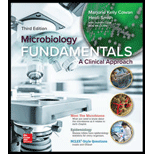
 NCLEX® PREP
NCLEX® PREP
1. Which of the following is/are considered to be an anabolic reaction? Select all that apply.
- a. Krebs cycle
- b. polypeptide synthesis
- c. cell assembly
- d. glycolysis
Introduction:
Anabolism is often referred to as biosynthesis. The term biosynthesis explains the formation of the molecules or the cellular structure. Energy is used in the formation of larger molecules from the smaller molecules.
Answer to Problem 1NP
Correct answer:
Polypeptide synthesis and cell assembly undergo anabolic reactions. Therefore, option (b) and (c) are correct.
Option (b) is given as “polypeptide synthesis”.
Option (c) is given as “cell assembly”.
Explanation of Solution
Justify the reasons for the correct statement:
Anabolism is the construction of a large molecule from its smaller unit molecules, polypeptides are the polymers of amino acids. Cell assembly is the group of neurons which is associated with a particular concept. With every new perception, a new nerve cell is generated.
Hence, options(b) and (c) arecorrect.
Justify the reasons for the incorrect statements:
Option (a) is given as “Krebs cycle”.
Krebs cycle is not an anabolic pathway because the intermediates of the cycles are notpolymers; they are obtained from the conversion of the substrate or by the removal of a group or attachment of a group. Hence, it is a wrong answer.
Option (d) is given as “Glycolysis”.
Glycolysis is a one-way catabolic chain reaction. Intermediates are not polymers of the substrates; they originate due to rearrangements of the functional groups or addition of some other groups. Hence, it is a wrong answer.
Hence, options (a) and(d) are incorrect.
Polypeptide synthesis and cell assembly are the examples of anabolic reactions because the formation of these molecules and cells involve the input of monomers. Krebs cycle and glycolysis are the examples of catabolic reactions.
Want to see more full solutions like this?
Chapter 7 Solutions
Microbiology Fundamentals: A Clinical Approach
- Alleles at the P locus control seed color. Plants which are pp have white seeds, white flowers and no pigment in vegetative parts. Plants which are P_ have black seeds, purple flowers and may have varying degrees of pigment on stems and leaves. Seed color can be assessed, visually, based on if the seed is white or not white A gene for mold resistance has been reported and we want to determine its inheritance and whether it is linked to P. For the purposes of this exercise, we will assume that resistance is controlled by a single locus M, and M_ plants are resistant and mm plants are susceptible. Resistance can be measured, under greenhouse conditions, 2 weeks after planting, by injecting each seedling with a spore suspension. After two weeks, the seedlings can be rated as resistant or susceptible, based on whether or not tissue is actively sporulating. For this exercise we will use seed and data from the F10 generation of a recombinant inbred population produced using single seed…arrow_forwardcan you help? I think its B but not surearrow_forwardSkip to main content close Homework Help is Here – Start Your Trial Now! arrow_forward search SEARCH ASK Human Anatomy & Physiology (11th Edition)BUY Human Anatomy & Physiology (11th Edition) 11th Edition ISBN: 9780134580999 Author: Elaine N. Marieb, Katja N. Hoehn Publisher: PEARSON 1 The Human Body: An Orientation expand_moreChapter 1 : The Human Body: An Orientation Chapter Questions expand_moreSection: Chapter Questions Problem 1RQ: The correct sequence of levels forming the structural hierarchy is A. (a) organ, organ system,... format_list_bulletedProblem 1RQ: The correct sequence of levels forming the structural hierarchy is A. (a) organ, organ system,... See similar textbooks Bartleby Related Questions Icon Related questions Bartleby Expand Icon bartleby Concept explainers bartleby Question Draw a replication bubble with two replication forks.blue lines are DNA single strands and red lines are RNA single strands.indicate all 3' and 5’ ends on all DNA single…arrow_forward
- Provide an answerarrow_forwardQuestion 4 1 pts Which of the following would be most helpful for demonstrating alternative splicing for a new organism? ○ its proteome and its transcriptome only its transcriptome only its genome its proteome and its genomearrow_forwardIf the metabolic scenario stated with 100 mM of a sucrose solution, how much ATP would be made then during fermentation?arrow_forward
- What is agricuarrow_forwardWhen using the concept of "a calorie in is equal to a calorie out" how important is the quality of the calories?arrow_forwardWhat did the Cre-lox system used in the Kikuchi et al. 2010 heart regeneration experiment allow researchers to investigate? What was the purpose of the cmlc2 promoter? What is CreER and why was it used in this experiment? If constitutively active Cre was driven by the cmlc2 promoter, rather than an inducible CreER system, what color would you expect new cardiomyocytes in the regenerated area to be no matter what? Why?arrow_forward
- What kind of organ size regulation is occurring when you graft multiple organs into a mouse and the graft weight stays the same?arrow_forwardWhat is the concept "calories consumed must equal calories burned" in regrads to nutrition?arrow_forwardYou intend to insert patched dominant negative DNA into the left half of the neural tube of a chick. 1) Which side of the neural tube would you put the positive electrode to ensure that the DNA ends up on the left side? 2) What would be the internal (within the embryo) control for this experiment? 3) How can you be sure that the electroporation method itself is not impacting the embryo? 4) What would you do to ensure that the electroporation is working? How can you tell?arrow_forward
 Biology: The Dynamic Science (MindTap Course List)BiologyISBN:9781305389892Author:Peter J. Russell, Paul E. Hertz, Beverly McMillanPublisher:Cengage Learning
Biology: The Dynamic Science (MindTap Course List)BiologyISBN:9781305389892Author:Peter J. Russell, Paul E. Hertz, Beverly McMillanPublisher:Cengage Learning Biology 2eBiologyISBN:9781947172517Author:Matthew Douglas, Jung Choi, Mary Ann ClarkPublisher:OpenStax
Biology 2eBiologyISBN:9781947172517Author:Matthew Douglas, Jung Choi, Mary Ann ClarkPublisher:OpenStax Human Heredity: Principles and Issues (MindTap Co...BiologyISBN:9781305251052Author:Michael CummingsPublisher:Cengage Learning
Human Heredity: Principles and Issues (MindTap Co...BiologyISBN:9781305251052Author:Michael CummingsPublisher:Cengage Learning





